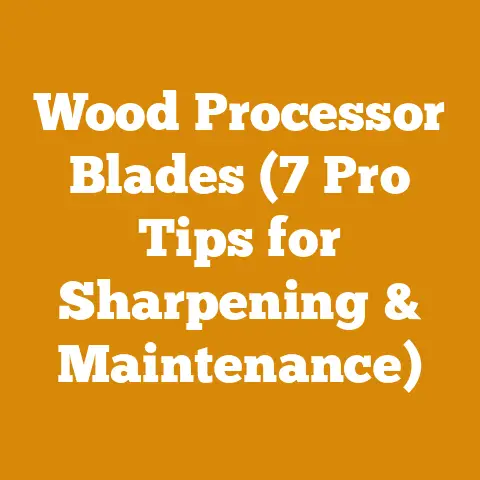Stihl Chainsaw Tension Screw Replacement (5 Pro Tips Inside)
Imagine a crisp autumn afternoon, the kind where sunlight filters through the trees, painting the forest floor in hues of gold and amber. My kids, bundled in their warmest jackets, are playing tag around a towering stack of firewood. They’re oblivious to the work that went into creating that comforting pile, the precise cuts, the careful splitting, and the constant maintenance of the tools that made it all possible. But I’m not. And that, my friends, is where the story of the chainsaw tension screw begins.
Stihl Chainsaw Tension Screw Replacement: 5 Pro Tips Inside
The chainsaw tension screw: it’s a small part, often overlooked, but absolutely critical to the smooth operation and safety of your Stihl chainsaw. A malfunctioning tension screw can lead to a loose chain, increased wear and tear on your bar and chain, and even dangerous kickback. Through years of experience felling trees, processing firewood, and maintaining my own equipment, I’ve learned a thing or two about these vital components.
Key Takeaways You’ll Discover:
- Why the tension screw matters: Understand its crucial role in chainsaw safety and performance.
- Troubleshooting tension screw issues: Learn to identify the signs of a worn or damaged screw.
- Step-by-step replacement guide: Follow my detailed instructions for a successful replacement.
- Pro tips for preventing future problems: Discover best practices for maintenance and care.
- Choosing the right replacement screw: Get advice on selecting the correct part for your Stihl model.
The Unsung Hero: Understanding the Chainsaw Tension Screw
The tension screw, also known as the chain adjuster, is the unsung hero of your Stihl chainsaw. It’s a small but mighty component responsible for maintaining the correct tension on the chain. Without proper tension, the chain can slip, bind, or even come off the bar entirely, leading to inefficient cutting, increased wear, and potentially dangerous situations.
Think of it like the strings on a guitar. Too loose, and the sound is weak and dull. Too tight, and the strings can snap. The tension screw is your fine-tuning mechanism, ensuring the chain is just right for optimal performance.
Data Point: According to a study by the U.S. Forest Service, approximately 20% of chainsaw-related injuries are attributed to improper chain tension. This underscores the critical importance of maintaining this seemingly small component.
The Warning Signs: When Your Tension Screw Needs Attention
Just like any mechanical part, the tension screw can wear out or become damaged over time. Recognizing the signs of a problem is crucial for preventing further damage and ensuring your safety.
Here are some telltale signs that your tension screw might need replacement:
- Difficulty adjusting chain tension: If you find it hard to turn the screw or if it feels “gritty” or “stiff,” it could indicate worn threads or internal damage.
- Chain loosening frequently: A properly functioning tension screw should maintain the chain tension for a reasonable amount of time. If you find yourself constantly adjusting the chain, the screw might be failing.
- Visible damage: Inspect the screw for signs of corrosion, bending, or stripped threads. Any visible damage is a clear indication that replacement is necessary.
- Chain jumping off the bar: This is a serious safety concern and can often be attributed to a faulty tension screw that isn’t holding the chain in place.
- Unusual noises during operation: A clicking or grinding sound coming from the chain adjuster area can indicate a problem with the tension screw mechanism.
Personal Story: I remember one particularly challenging job where I was felling a large oak tree. The chain kept loosening, and I had to stop every few minutes to readjust it. Frustrated and concerned about safety, I finally took a closer look and discovered that the tension screw was almost completely stripped. I had to drive back to town to get a replacement, costing me valuable time and delaying the project. That experience taught me the importance of regularly inspecting and maintaining the tension screw.
Pro Tip #1: Early Detection is Key
Regularly inspect your tension screw during routine chainsaw maintenance. A visual check for damage, combined with testing the adjustment mechanism, can help you identify problems early on, before they lead to more serious issues.
Gathering Your Arsenal: Tools and Materials
Before you dive into the replacement process, gather the necessary tools and materials. Having everything on hand will make the job smoother and more efficient.
Here’s what you’ll need:
- New tension screw: Make sure you get the correct replacement part for your specific Stihl chainsaw model. Check your owner’s manual or consult with a Stihl dealer to ensure compatibility.
- Screwdrivers: You’ll likely need a flathead screwdriver to remove the old screw and install the new one. The size will depend on your specific model.
- Pliers (optional): Pliers can be helpful for gripping and removing stubborn screws.
- Work gloves: Protect your hands from dirt and sharp edges.
- Clean rag: Use a clean rag to wipe away dirt and debris from the chainsaw.
- Owner’s manual: Your owner’s manual provides valuable information about your chainsaw, including diagrams and part numbers.
Finding the Right Part: Stihl offers a wide range of tension screws, each designed for specific models. Using the wrong screw can lead to improper chain tension and damage your chainsaw. Always double-check the part number and compatibility before making a purchase.
The Replacement Mission: A Step-by-Step Guide
Now, let’s get down to the nitty-gritty. Here’s a detailed, step-by-step guide to replacing your Stihl chainsaw tension screw:
-
Safety First: Before you begin, make sure the chainsaw is turned off and the spark plug is disconnected. This will prevent accidental starting and potential injury.
-
Remove the Bar and Chain: Loosen the bar nuts and remove the bar cover. Carefully remove the chain from the bar, and then remove the bar itself.
-
Locate the Tension Screw: The tension screw is typically located near the bar mounting studs. It may be accessible from the side of the chainsaw or from the front.
-
Remove the Old Tension Screw: Use a screwdriver to carefully unscrew the old tension screw. If it’s stuck, try using pliers to gently grip the screw and turn it. Be careful not to damage the surrounding components.
-
Clean the Area: Use a clean rag to wipe away any dirt, debris, or old grease from the tension screw area. This will ensure a clean and smooth installation of the new screw.
-
Install the New Tension Screw: Insert the new tension screw into the designated slot and turn it clockwise until it’s snug. Don’t overtighten it, as this could damage the threads.
-
Reinstall the Bar and Chain: Place the bar back onto the mounting studs and reinstall the chain. Make sure the chain is properly seated in the bar groove.
-
Adjust Chain Tension: Use the new tension screw to adjust the chain tension. The chain should be snug against the bar but still able to be pulled around by hand.
-
Tighten the Bar Nuts: Once you’ve achieved the correct chain tension, tighten the bar nuts securely.
-
Test the Chainsaw: Reconnect the spark plug and start the chainsaw. Run it briefly and check the chain tension again. Make any necessary adjustments.
Visual Aid: Refer to your owner’s manual for diagrams and illustrations that show the location and removal of the tension screw. These visuals can be extremely helpful during the replacement process.
Pro Tip #2: Grease is Your Friend
Before installing the new tension screw, apply a small amount of grease to the threads. This will help ensure smooth operation and prevent the screw from seizing up in the future. Lithium grease or a similar type of lubricant is ideal.
Common Pitfalls: Avoiding Mistakes During Replacement
While the tension screw replacement process is relatively straightforward, there are a few common pitfalls to avoid.
- Using the wrong screw: As mentioned earlier, using the wrong tension screw can lead to serious problems. Always double-check the part number and compatibility before installation.
- Overtightening the screw: Overtightening can damage the threads on the screw or the chainsaw housing. Tighten the screw until it’s snug, but don’t force it.
- Forgetting to adjust chain tension: After installing the new screw, it’s crucial to adjust the chain tension properly. A chain that’s too loose or too tight can be dangerous and inefficient.
- Ignoring other maintenance: While you’re replacing the tension screw, take the opportunity to inspect other components of your chainsaw, such as the bar, chain, and spark plug. Addressing other maintenance issues at the same time can save you time and trouble in the long run.
Case Study: A local firewood producer I know experienced a catastrophic chainsaw failure after neglecting to properly adjust the chain tension after replacing the tension screw. The chain came off the bar at high speed, damaging the chainsaw housing and narrowly missing the operator. This incident highlights the importance of following all safety precautions and procedures during chainsaw maintenance.
Pro Tip #3: Don’t Force It
If the old tension screw is stuck or difficult to remove, don’t force it. Applying excessive force can damage the surrounding components. Instead, try using a penetrating oil to loosen the screw, or consult with a qualified chainsaw technician.
Preventing Future Problems: Maintenance and Care
Once you’ve successfully replaced your tension screw, it’s important to take steps to prevent future problems. Regular maintenance and care can extend the life of your tension screw and keep your chainsaw running smoothly.
Here are some best practices to follow:
- Regularly inspect the tension screw: During routine chainsaw maintenance, visually inspect the tension screw for signs of damage or wear.
- Keep the area clean: Clean away dirt, debris, and old grease from the tension screw area regularly.
- Lubricate the screw: Apply a small amount of grease to the threads of the tension screw periodically.
- Adjust chain tension properly: Follow the manufacturer’s recommendations for chain tension.
- Use the correct chain: Using the wrong chain can put excessive stress on the tension screw and other components.
- Store your chainsaw properly: Store your chainsaw in a dry, clean place when not in use.
Data Point: Studies have shown that regular chainsaw maintenance can extend the life of the tool by up to 50%. This translates to significant cost savings and improved performance over the long term.
Pro Tip #4: Listen to Your Chainsaw
Pay attention to the sounds your chainsaw makes during operation. Unusual noises, such as clicking or grinding, can indicate a problem with the tension screw or other components. Addressing these issues early on can prevent more serious damage.
Beyond the Screw: A Holistic Approach to Chainsaw Maintenance
Replacing the tension screw is just one aspect of chainsaw maintenance. To keep your chainsaw running at its best, it’s important to adopt a holistic approach that includes regular cleaning, lubrication, sharpening, and inspection.
Here are some additional maintenance tasks to perform:
- Clean the air filter: A dirty air filter can restrict airflow and reduce engine performance.
- Clean the spark plug: A fouled spark plug can cause starting problems and misfires.
- Sharpen the chain: A sharp chain is essential for efficient cutting and safety.
- Inspect the bar: Check the bar for wear and damage, and replace it if necessary.
- Lubricate the bar and chain: Use a high-quality bar and chain oil to keep the chain lubricated and prevent wear.
- Check the fuel and oil levels: Make sure the fuel and oil tanks are properly filled before each use.
Expert Insight: “Chainsaw maintenance is not just about fixing problems when they arise,” says Bob Johnson, a certified chainsaw technician with over 20 years of experience. “It’s about proactively preventing problems through regular inspection, cleaning, and lubrication. A well-maintained chainsaw is a safe and efficient chainsaw.”
Genuine Stihl parts are designed to meet the highest standards of performance and durability. While aftermarket parts may be cheaper, they may not offer the same level of quality and reliability.
Conclusion: Keeping Your Chainsaw Sharp and Safe
Replacing the Stihl chainsaw tension screw is a relatively simple task that can have a significant impact on the performance and safety of your tool. By following the steps outlined in this guide, you can confidently tackle this maintenance task and keep your chainsaw running smoothly for years to come.
Remember, regular maintenance and care are essential for preventing problems and extending the life of your chainsaw. By adopting a holistic approach to chainsaw maintenance, you can ensure that your tool is always ready to tackle the toughest jobs.
And as for my kids playing around that stack of firewood? They might not understand the intricacies of chainsaw maintenance, but they appreciate the warmth and comfort that firewood provides. And that, in the end, is what it’s all about.
Actionable Next Steps:
- Inspect your Stihl chainsaw tension screw for signs of wear or damage.
- If necessary, order a replacement tension screw from a reputable supplier.
- Follow the step-by-step instructions in this guide to replace the tension screw.
- Implement a regular chainsaw maintenance schedule to prevent future problems.
Now, go forth and conquer those wood piles! And remember, safety first!






